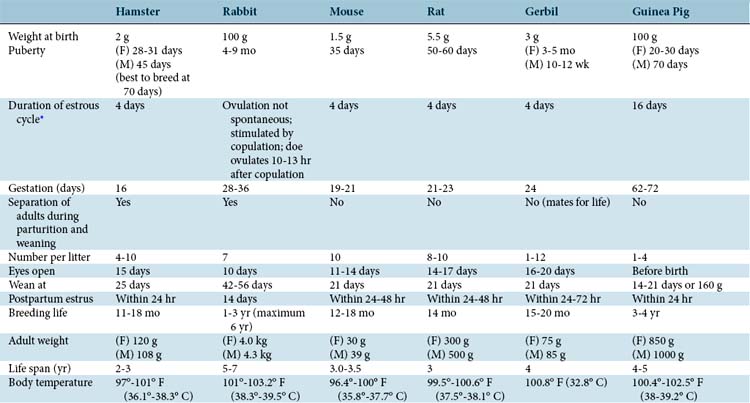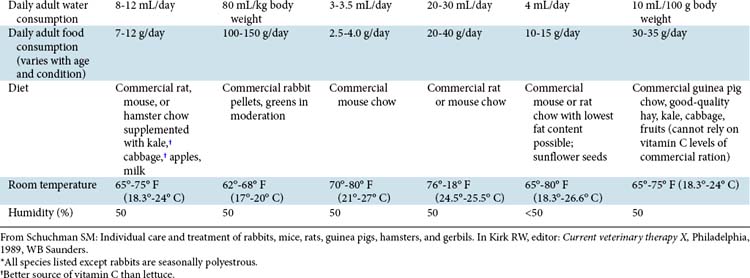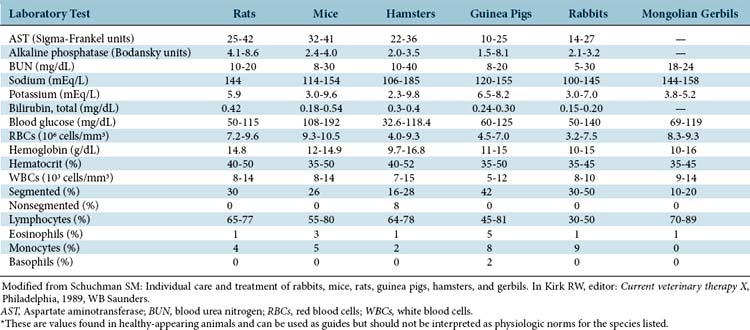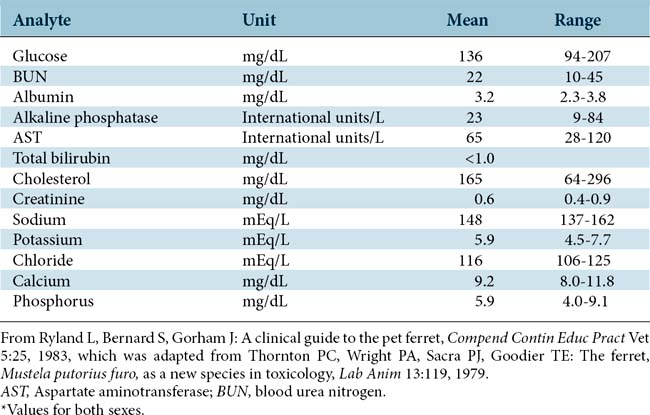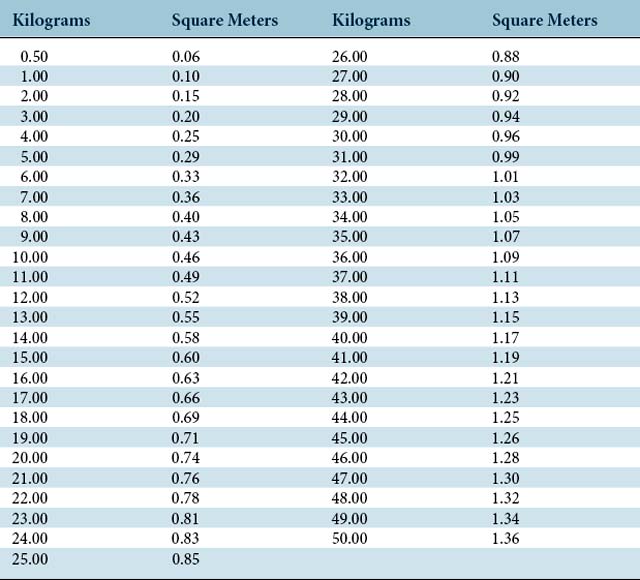Section 6 Charts and Tables
Dog Breeds Recognized by the American Kennel Club (AKC),
Cat Breeds Recognized by the Cat Fanciers’ Association (CFA),
Useful Information for Rodents and Rabbits,
Determination of the Sex of Mature and Immature Rodents and Rabbits,
Blood Values and Serum Chemical Constituents for Rodents and Rabbits,
Ferrets—Physiologic, Anatomic, and Reproductive Data,
Hematologic Values for Normal Ferrets,
Serum Chemistry Values for Normal Ferrets,
Electrocardiographic Data for Normal Ferrets,
Conversion of Body Weight in Kilograms to Body Surface Area in Square Meters for Dogs,
Conversion of Body Weight in Kilograms to Body Surface Area in Square Meters for Cats,
French Scale Conversion Table,
International System of Units (SI) Conversion Guide
Units of Length, Volume, and Mass in the Metric System
Vaccines Licensed for Use in Dogs in the United States
Vaccines Licensed for Use in Cats in the United States
Canine Vaccination Recommendations—Initial Puppy Series
Canine Vaccination Recommendations—Adult
Feline Vaccination Recommendations—Initial Kitten Series
Feline Vaccination Recommendations—Adult
Compendium of Animal Rabies Prevention and Control, 2005, National Association of State Public Health Veterinarians, (NASPHV)
Prescription Writing Reference: Do’s and Don’ts
| Need | Agency | Phone Number and Web Address |
|---|---|---|
| To obtain information regarding the treatment of a known or suspected poisoning or toxicosis case | American Society for the Prevention of Cruelty to Animals (ASPCA) Animal Poison Control Center. A $65 fee for service may apply. | 888-426-4435 www.aspca.org Search: pet care; animal poison control |
| To obtain information regarding the treatment of a known or suspected poisoning or toxicosis case | Pet Poison Helpline Available 24 hours; a $35 fee is charged per case. | 800-213-6680 |
| To report known or suspected adverse drug (not vaccine) reactions | Food and Drug Administration (FDA), Center for Veterinary Medicine (CVM) | 888-332-8387 (voice messages accepted)www.fda.gov Search: animal and veterinary |
| To report shortages of medically necessary veterinary drugs | Food and Drug Administration (FDA), Center for Veterinary Medicine (CVM) | 240-276-9239 |
| To report known or suspected adverse vaccine reactions | U.S. Dept of Agriculture (USDA), Center for Veterinary Biologics It is recommended to contact the vaccine manufacturer directly before contacting the USDA. Note: This is for reporting purposes only. | 800-752-6255 www.aphis.usda.gov Search: vaccine adverse event |
| For inquiries regarding transfusion medicine | Animal Blood Bank hotline (no charge to caller) | 800-243-5759 (24-hour) www.animalbloodbank .com |
| For inquiries regarding transfusion medicine and purchase of blood and blood components | Eastern Veterinary Blood Bank | 800-949-3822 (24-hour) www.evbb.com |
| For inquiries regarding transfusion medicine—a full-service, nonprofit blood bank and educational network for animal treatment | HEMOPET | 714-891-2022 (24-hour) www.hemopet.org |
| Access to a commercial blood bank and purchase of blood and blood components | Veterinarians’ Blood Bank | 812-358-8500 www.vetbloodbank.com |
| For inquiries regarding pesticides, pesticide products, poisonings, and toxicities | National Pesticide Information Center | 800-858-7378 |
| For inquiries regarding pet shipping regulations and regulations for shipping pets on airlines | U.S. Dept of Agriculture (USDA) (voice response service) | 800-545-8732 www.aphis.usda.gov Search: pet travel |
| To contact the Office of Diversion Control of the DEA | Drug Enforcement Administration (DEA) | 800-882-9539 www.dea.gov |
Table 6-2 Dog Breeds Recognized by The American Kennel Club (AKC)
| The American Kennel Club (AKC) currently recognizes 150 dog breeds, each of which is assigned to one of seven breed groups. The AKC maintains an excellent website that offers considerable information on individual breeds (www.akc.org/breeds/index.cfm). |
| Sporting group |
|---|
| Hound group |
|---|
| Working group |
|---|
| Terrier group |
|---|
| Toy group |
|---|
| Non-sporting group |
|---|
| Herding group |
|---|
| Miscellaneous class |
|---|
Table 6-3 Cat Breeds Recognized by the Cat Fanciers’ Association (CFA)
| The Cat Fanciers’ Association (CFA) presently recognizes 41 pedigreed breeds for showing in the Championship Class. For additional information on individual breeds, see the CFA website, www.cfa.org (Search: Breeds) |
| Championship class |
|---|
Table 6-5 Determination of the Sex of Mature and Immature Rodents and Rabbits
| Male | Female |
|---|---|
| Mature hamsters, mice, rats, guinea pigs, and gerbils | |
| Anogenital distance longer in the male. Manipulate “genital papilla” (prepuce) to the protrude penis. Palpate for testicles either in a scrotal sac (if present) or subcutaneous in inguinal region. Males have only two external openings in the inguinal area: | Anogenital distance shorter in the female. Look for the three external openings in inguinal area: b. Vaginal orifice (middle opening)—look carefully c. Urethral orifice at tip of urethral papilla (most anterior opening). In these animals the urethral papilla is located outside the vagina (unlike in dogs and cats). In very fat or young females, the vaginal orifice may be either hidden by folds of skin (the former) or sealed (latter). Gentle manipulation of the skin in this area will divulge the orifice. |
| Mature rabbits | |
|---|---|
| Protrude penis by manipulating skin of prepuce. Palpate for testicles. Anogenital distance is longer in males. | There is a common orifice for both the vagina and urethra (as in dogs and cats). No structure like a “penis” can be protruded from the urogenital orifice. Anogenital distance is shorter in females. |
From Schuchman SM: Individual care and treatment of rabbits, mice, rats, guinea pigs, hamsters, and gerbils. In Kirk RW, editor: Current veterinary therapy X, Philadelphia, 1989, WB Saunders.
Table 6-7 Ferrets—Physiologic, Anatomic, and Reproductive Data
| Data | Range or Value |
|---|---|
| Physiologic data | |
| Life span | 5-9 yr (average 5-7) |
| Commercial breeding life | 2-5 yr |
| Body temperature | 101°-104° F (38°-40° C) |
| Respiratory rate | 32-36 breaths/min |
| Heart rate | 220-250 beats/min (average 240) |
| Water consumption | 75-100 mL/day |
| Chromosome number | 2n = 40 |
| Anatomic data | |
|---|---|
| Dental formula | 2 (I3/3, C1/1, P3/4, M1/2) |
| Vertebral formula | C-7, T-14, L-6, S-3, Cd-14–Cd-18 |
| Reproductive data | |
|---|---|
| Gestation | 39-46 days (average 42) |
| Litter size | 2-17 kits (average 8) |
| False pregnancy | 40-42 days |
| Placentation | Zonal |
| Implantation time | 12-31 days |
| Weaning | 5-6 wk |
| Ovulation | 30-40 hr postcoitus |
From Randolph RW: Medical and surgical care of the pet ferret. In Kirk RW, editor: Current veterinary therapy X, Philadelphia, 1989, WB Saunders.
Table 6-8 Hematologic Values for Normal Ferrets*
| Laboratory Test | Mean | Range |
|---|---|---|
| Hematocrit (%) | 52.3 | 42-61 |
| Hemoglobin (g/dL) | 17.0 | 15-18 |
| RBCs (106 cells/mm3) | 9.17 | 6.8-12.2 |
| WBCs (103 cells/mm3) | 10.1 | 4.0-19 |
| WBCs | ||
|---|---|---|
| Lymphocytes (%) | 34.5 | 12-54 |
| Neutrophils (%) | 58.3 | 11-84 |
| Monocytes (%) | 4.4 | 0-9.0 |
| Eosinophils (%) | 2.5 | 0-7.0 |
| Basophils (%) | 0.1 | 0-2.0 |
| Reticulocytes (%) | 4.6 | 1-14 |
| Platelets (103 cells/mm3) | 499 | 297-910 |
| Total protein (g/dL) | 6.0 | 5.1-7.4 |
RBCs, Red blood cells; WBCs, white blood cells.
From Ryland L, Bernard S, Gorham J: A clinical guide to the pet ferret, Compend Contin Educ Pract Vet 5:25, 1983, which was adapted from Thornton PC, Wright PA, Sacra PJ, Goodier TE: The ferret, Mustela putorius furo, as a new species in toxicology, Lab Anim 13:119, 1979.
Table 6-10 Electrocardiographic Data for Normal Ferrets*
| Parameter | Mean | Range |
|---|---|---|
| Rate rhythm | 224 ± 51 | 150-340 bpm |
| Measurements | ||
|---|---|---|
| P wave | ||
| Width | 0.03 ± 0.009 | 0.015-0.04 s |
| Height | 0.106 ± 0.03 | 0.05-0.20 mV |
| PR interval | ||
| Width | 0.05 ± 0.01 | 0.04-0.08 s |
| QRS complex | ||
| Q wave | Usually none | |
| R wave | ||
| Width | 0.049 ± 0.008 | 0.04-0.06 s |
| Height | 1.59 ± 0.63 | 0.6-3.15 mV |
| S wave | ||
| Height | 0.166 ± 0.101 | 0.1-0.25 mV |
| ST segment | ||
| Width | 0.030 ± 0.016 | 0.01-0.06 s |
| QT interval | ||
| Width | 0.13 ± 0.027 | 0.10-0.18 s |
| T wave | ||
| Width | 0.06 ± 0.01 | 0.03-0.1 s |
| Height | 0.24 ± 0.12 | 0.10-0.45 mV |
| Mean electrical axis (frontal plane) | +65-100 degrees |
bpm, Beats per minute; s, seconds; mV, millivolts.
* Ferrets in right lateral recumbency; sedation with ketamine and xylazine.
Stay updated, free articles. Join our Telegram channel

Full access? Get Clinical Tree


